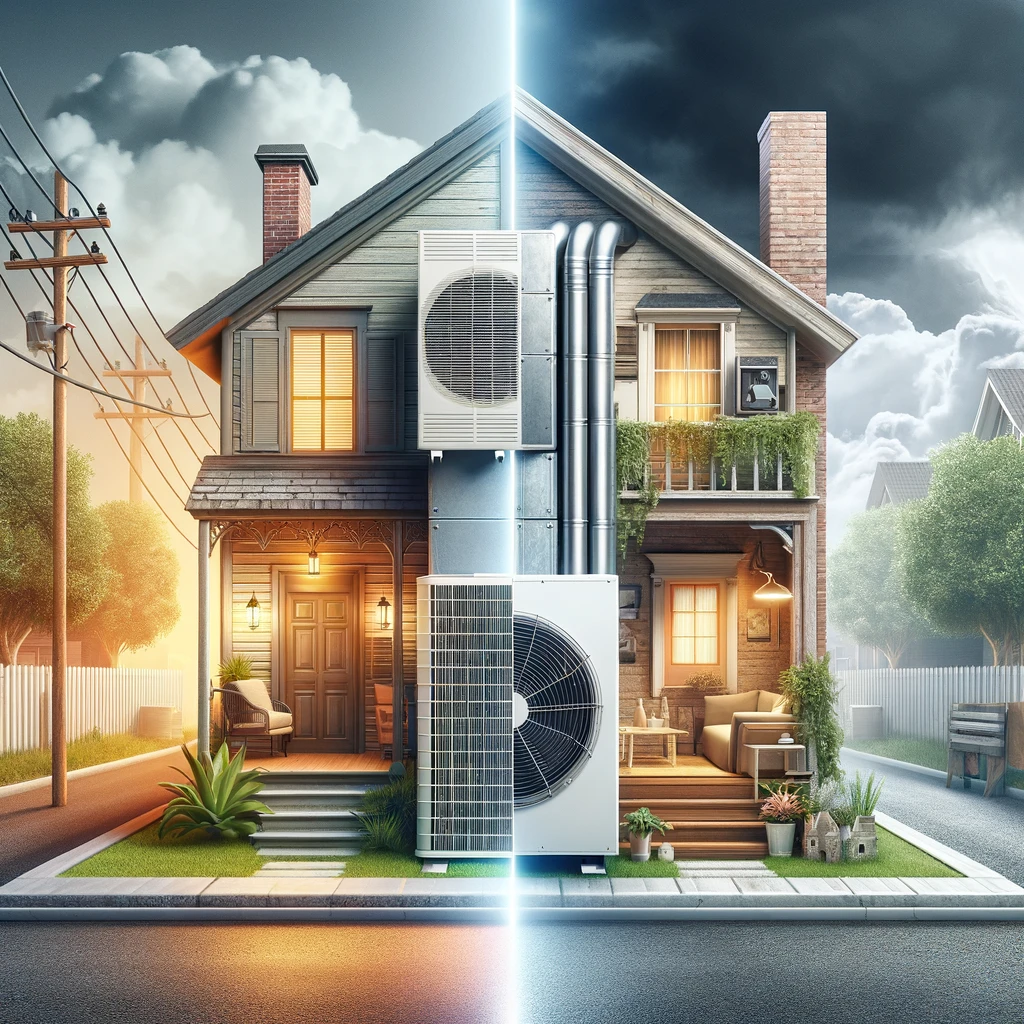Common Reasons to Consider HVAC Upgrade or Replacement
- Poor Performance:
- Fluctuating temperatures, uneven heating or cooling, or inability to maintain set temperatures.
- Drafts causing discomfort.
- Inadequate ventilation leading to staleness, slow moisture and odor removal.
- Increased illness and health issues.
- Poor humidity control (too dry or too moist).
- Excessive system noise.
- High energy bills unrelated to weather conditions.
- End-of-Life:
- HVAC equipment has a finite lifespan, and older systems may suffer from reduced comfort and increased energy use.
- Equipment breakdowns may necessitate repairs or replacements.
- Newer, more efficient options may make sense, even if existing equipment still functions.
- Residential HVAC systems over 15 years old are nearing the end of their useful life.
- Addition and Expansion:
- Structural additions to a building may require new equipment to handle increased heating and cooling loads.
- If expansion exceeds the capacity of the existing system, options include replacing the old system or installing a dedicated system for the addition.
- Building Energy Upgrade:
- Renovations that improve insulation and reduce energy use can lead to oversized and inefficient existing HVAC systems.
- Newer, more efficient equipment can better match reduced heating and cooling loads.
- Tightening the building envelope may impact ventilation and air quality, requiring additional venting or ventilation.
HVAC Options: Retain, Upgrade, or Replace
- Retaining the Current HVAC System:
- Conduct retro-commissioning to ensure the system operates according to specifications.
- Prioritize maintenance to improve performance.
- Refer to ENERGY STAR Checklists for guidance.
- Upgrading, Expanding, or Adding to the HVAC System:
- Consider upgrading or expanding the system if it doesn’t meet replacement criteria.
- Evaluate the current system’s capacity for additions and assess ductwork.
- Address deficiencies like humidity control and ventilation.
- Replacing the HVAC System:
- Residential HVAC systems over 15 years old may need replacement.
- Consider factors like efficiency, purchase, and installation costs.
- Calculate potential savings with a higher efficiency system.
- Explore replacement options and choose the best-fit system for your needs.
- HVAC System Replacement Options:
- Replace “in-kind” with a modern version of the same type of equipment.
- Explore changing to a different type of system for improved performance or specific requirements.
- Consider factors like energy sources, comfort, aesthetics, and system capacity.
HVAC Assessment, Code Compliance, Safety, and Installation
- A thorough assessment of heating, cooling equipment, distribution system, and building conditions is essential.
- Compliance with federal, state, and local regulations is crucial, and the assessment should be conducted by a licensed or certified contractor.
- Inspect basements, crawlspaces, or attics where HVAC equipment may be located, considering venting, insulation, and conditioning.
- Address potential stop-work conditions like knob and tube wiring, asbestos insulation, bathroom fan venting, water leaks, unvented heaters, duct issues, flooring problems, mold, and pests before proceeding with HVAC work.
Potential Stop-Work Conditions during HVAC Assessment
Active Knob-and-Tube Wiring or Exposed Wiring
- Solution: Rewire the house before starting HVAC work if active knob-and-tube wiring or exposed wiring poses a safety threat.
Moisture in Crawlspace, Basement, or Attic
- Solution: If moisture is present, consider a mold remediation professional for an in-depth inspection and proper remediation. Work cannot proceed until the space is certified clean. Address the source of moisture. Consider supplemental dehumidification in conditioned spaces if mold is found.
HVAC Equipment in the Attic
- Solution: Refer to the “Pre-Retrofit Assessment of Attics, Ceilings, and Roofs” for guidance.
HVAC Equipment in the Crawlspace or Basement
- Solution: Refer to the “Pre-Retrofit Assessment of Crawlspaces and Basements” for guidance.
Natural-Draft Combustion Appliance in the House
- Solution: Ensure adequate makeup air is provided to the appliance. For sealed crawlspace or basement renovations, replace natural-draft appliances with sealed combustion appliances vented to the outside or duct adequate supply air from an outside source. See EPA Protocols for details.
Bathroom Fans Vented into the Attic:
- Solution: Vent bathroom fans to the outside before proceeding with additional work. Check for mold near duct outlets.
Suspected Asbestos Insulation, Tape, or Fireproofing on Existing HVAC:
- Solution: Obtain professional advice before attempting removal.
Survey and Inventory:
- Conduct a comprehensive survey of the current HVAC system.
- Develop a line drawing of the house’s layout, including proposed changes.
- Map conditioning devices and equipment.
- Note insulation levels, window types, orientation, sizes, and construction attributes.
- Photograph components and equipment nameplates for reference.
- Gather information about the homeowner’s preferences and knowledge related to the system and energy use.
HVAC Assessment Checklist (Includes, but not limited to):
Furnaces:
- Check combustion air and venting.
- Inspect gas piping requirements.
- Address cracked heat exchangers.
- Considerations when replacing with a higher AFUE furnace.
Motors:
- Address noisy fans and pumps.
- Replace inefficient fan motors or compressors.
Electrical:
- Ensure proper electrical disconnects and sizing.
Condensate:
- Ensure proper drainage and pan functionality.
- Address condensate issues.
Air Conditioner/Heat Pump:
- Check compressors and refrigerant.
- Address low refrigerant charge and leaks.
- Verify condenser pad and wall bracket.
Controls:
- Check thermostat functionality.
- Assess ventilation, humidity, and zone controls.
Distribution:
- Seal return grilles in certain areas.
- Assess supply register placement and size.
- Check return ducts for noise and resistance.
- Conduct duct air leakage testing.
- Inspect insulation and location of ducts.
Mechanical Ventilation:
- Check/measure whole-house mechanical ventilation.
- Assess bath and kitchen exhaust fans.
- Ensure dryer vent functionality.
Filtration:
- Check and replace system filters.
- Consider higher efficiency media filters.
Whole-House Performance Assessment:
- Consider a Home Performance Energy Assessment for a holistic view of the building envelope and interconnected systems.
Code Compliance:
- Follow applicable codes and regulations during all work.
Safety:
- Adhere to safety precautions and equipment shut-off procedures.
- Handle hazardous materials appropriately.
Demolition:
- Remove debris and old equipment properly, especially if it contains refrigerant.
Equipment Sizing:
- Perform load calculation using ACCA Manual J and size equipment according to ACCA Manual S.
- Discuss sizing implications with the homeowner.
Equipment Installation:
- Follow manufacturer specifications for installation.
- Remove packaging materials and restore architectural details.
- Address safety requirements for new, efficient equipment.
- Commission equipment per manufacturer’s instructions.
- Provide homeowner with manuals and warranty paperwork.
- Inform homeowner of energy rebates or incentives.
In conclusion, conducting a thorough HVAC assessment is crucial before any HVAC intervention or renovation. It helps identify potential stop-work conditions and ensures the safety, efficiency, and functionality of the HVAC system. Addressing issues like active knob-and-tube wiring, moisture, improper venting, and more is essential to provide a safe environment for homeowners and prevent any complications during the HVAC work.
For immediate service or consultation, you may contact us at Allied Emergency Services, INC.
Contact Information:
- Phone: 1-800-792-0212
- Email: Info@AlliedEmergencyServices.com
- Location: Serving Illinois, Wisconsin, and Indiana with a focus on the greater Chicago area.
If you require immediate assistance or have specific questions, our human support is readily available to help you.
Disclaimer: This article is intended for informational purposes only. For professional advice, consult experts in the field.










